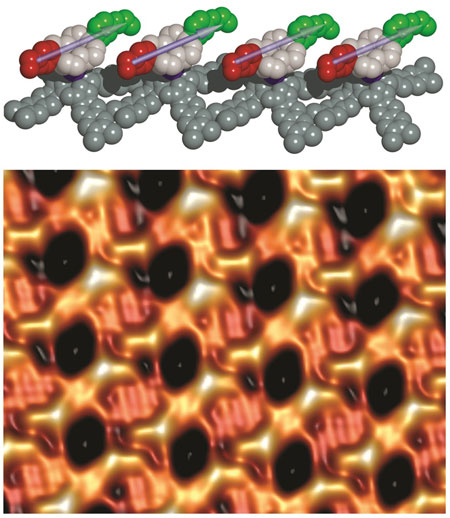| Posted: May 10, 2016 |
Scientists develop synchronized molecular motors
(Nanowerk News) An international team of scientists has created molecular motors that can communicate and synchronize their movements.
|
|
The team, led by physicist Saw-Wai Hla of Ohio University, published an Advanced Online Publication today in the journal Nature Nanotechnology ("Simultaneous and coordinated rotational switching of all molecular rotors in a network") demonstrating that scientists can control the coordinated motions of tiny machines at the nanoscale. The research has implications for the future development of technologies that can be used in computers, photonics and electronics as well as novel nanoscale devices.
|
 |
| (Top) This illustration shows parallel motors with dipolar rotator arms indicated by arrows. The green and red units represent negative and positive charges. (Bottom) Scanning tunneling microscope image showing a parallel arrangement of dipolar motor assembly. (Image: Saw-Wai Hla)
|
|
“Our goal is to mimic natural biological machines by creating synthetic machines we can control,” said Hla, a professor of physics and astronomy.
|
|
Hla’s team observed up to 500 molecular motors move simultaneously in the same direction when the scientists applied 1 volt of energy through the tip of a scanning tunneling microscope. At lower levels of energy, the motors also rotated, but in different directions. However, this motion was not random, but showed patterns of coordination, Hla said.
|
|
In the experiment, scientists observed the synchronized movements at minus 316 degrees Fahrenheit.
|
|
The motors have two decks: The upper deck is the rotor and the lower deck is the stator, which has eight sulfur atoms that act as atomic glue to stick to surfaces of gold or copper. The rotating and stationary decks are connected with an atom of europium that serves as an atomic ball bearing.
|
|
Scientists at CEMES/CNRS in France synthesized the molecular motors, which include a dipole in the rotor arms, which means that they have a positive and negative side. This unique feature allows the individual motors to communicate and coordinate their motions, Hla’s team found.
|
|
In addition, the scientists learned that a hexagon arrangement of the motors is key for the synchronization, as it allows the motors to effectively communicate.
|
|
The molecular motors create a ferroelectric system, which is a prized property of materials used in various electronic devices, Hla added.
|
|
The nanomotors are so small that scientists can fit 44,000 billion of them in a 1 centimeter square area.
|
|
“One of the goals of nanotechnology is to assemble billions of nanomachines packed into a tiny area that can be operated in a synchronized manner to transport information or to coherently transfer energy to multiple destinations within nanometer range,” Hla explained.
|

